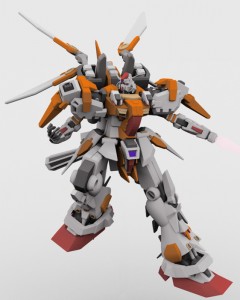 In my previous post on this topic, I suggested a few basic rules for a giant robot RPG system using the basic D&D 4E rules.
In my previous post on this topic, I suggested a few basic rules for a giant robot RPG system using the basic D&D 4E rules.
Let’s review the rules so far:
Mecha operate on a scale 10x that of the human scale. So, mecha weapons do 10x the damage of a human weapon, mecha are about 10x bigger than humans, etc.
Mecha combat occurs on its own grid, which does not represent individual human units. Similarly, human-scaled combat does not show mecha units.
Pilot characters have all six stats, while mecha have only Strength, Constitution, and Dexterity. Any mecha attacks targeting those three stats are assumed to be targeting the mecha’s stats, rather than the pilot’s. All other attacks target the pilot’s stats.
Mecha have Reflex and Fortitude defenses, but no Will defense.
Mecha have at-will powers. PCs have encounter and daily powers.
I’ve received some feedback suggesting that I keep full stats for both mecha and pilots. It’s an interesting idea, allowing for attacks that target a mecha and different ones that target the pilot inside. However, if I do that, then the DM and players will have a much larger workload. Each attack must specify whether it’s targeting a mecha’s defense or a PC’s defense, and DMs and players will have to keep track of all those stats. I may go in that direction, but I’m going to hash out some examples before I decide.
Now, let’s talk races and classes.
Racial Profiling
D&D is built on the premise that the world contains many intelligent races. In contrast, most mecha anime series have at most one non-human race: Macross/Robotech has Zentraedi, Gundam Seed has Coordinators, and U.C. Gundam has Newtypes (if you want to push the concept of Newtypes that far),.
I can see two obvious solutions to this:
- Live with it. Any given mecha universe may only include one or two races.
- Replace race with military organization. You choose the military organization that trained you, and this affects your stats in the same way that race does in D&D.
I like the latter, so we’ll go with that except in universes that legitimately include several playable races/species. So:
PC race is replaced with “military organization,” which reflects the military group that primarily trained the PC.
Class can remain unchanged. Obviously, there will be different classes, but the mechanics will work the same.
What Species is a Giant Robot?
A mecha’s race must be represented by its manufacturer. Different companies manufacture mecha to different specs. Makes sense.
Class corresponds to the mecha’s intended role in combat. Just like other military machinery fill certain roles (fighter vs. bomber), mecha have roles as well. The term “class” makes sense for mecha, so we’ll keep that.
Mecha race is replaced with “manufacturer.” Class remains unchanged.
Okay, so race/class now falls out as follows:
- PC Military Organization
- PC Class
- Mecha Manufacturer
- Mecha Class
(I will note there that I dislike the term “class” in general. It’s vague, making it unhelpful; it might as well be called “category” or “set.” Terms should add flavor to the world. I’d be tempted to replace PC class with “specialty” and Mecha class with “role,” but that would confuse all those D&D players out there. And since this is meant to be a D&D 4E conversion, I’ll stick with “class.”)
Can a Giant Robot be Bloodied?
Le’ts fix a few naming issues while we’re at it.
Giant robots don’t get bloodied, and you don’t heal a 20-ton war machine. So:
The term “bloodied” is replaced with “sparking,” and the term “healing surge” is replaced with “repair operation.” Mechanically, they work the same.
Confusion
This is getting complicated. Character creation in D&D 4E consumes enough time as it is. Now we have to generate a mecha, too?
Well, let’s make it easy. The system description document will include a bunch of pre-generated mecha. Players can generate mecha from scratch if they want to, but beginners will be encouraged to just pick a pre-generated mecha.
So that’s more of a design goal: Develop a bunch of mecha for players to pilot. In the next post in this series, we’ll create a basic blank sheet of stats and fields for mecha, as well as one for PCs.
